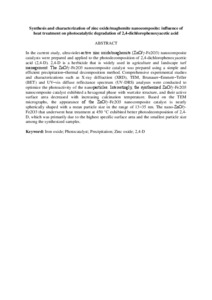Citation
Kian, Mun Lee and Abdullah, Abdul Halim
(2015)
Synthesis and characterization of zinc oxide/maghemite nanocomposite: influence of heat treatment on photocatalytic degradation of 2,4-dichlorophenoxyacetic acid.
Materials Science in Semiconductor Processing, 30.
pp. 298-306.
ISSN 1369-8001; ESSN: 1873-4081
Abstract
In the current study, ultraviolet-active zinc oxide/maghemite (ZnO/γ-Fe2O3) nanocomposite catalysts were prepared and applied to the photodecomposition of 2,4-dichlorophenoxyacetic acid (2,4-D). 2,4-D is a herbicide that is widely used in agriculture and landscape turf management. The ZnO/γ-Fe2O3 nanocomposite catalyst was prepared using a simple and efficient precipitation–thermal decomposition method. Comprehensive experimental studies and characterizations such as X-ray diffraction (XRD), TEM, Brunauer–Emmett–Teller (BET) and UV–vis diffuse reflectance spectrum (UV-DRS) analyses were conducted to optimize the photoactivity of the nanoparticles. Interestingly, the synthesized ZnO/γ-Fe2O3 nanocomposite catalyst exhibited a hexagonal phase with wurtzite structure, and their active surface area decreased with increasing calcination temperature. Based on the TEM micrographs, the appearance of the ZnO/γ-Fe2O3 nanocomposite catalyst is nearly spherically shaped with a mean particle size in the range of 13–35 nm. The nano-ZnO/γ-Fe2O3 that underwent heat treatment at 450 °C exhibited better photodecomposition of 2,4-D, which was primarily due to the highest specific surface area and the smallest particle size among the synthesized samples.
Download File
![[img]](http://psasir.upm.edu.my/46461/1.hassmallThumbnailVersion/Synthesis%20and%20characterization%20of%20zinc%20oxidemaghemite%20nanocomposite%20influence%20of%20heat%20treatment%20on%20photocatalytic%20degradation%20of%202%2C4-dichlorophenoxyacetic%20acid.pdf)  Preview |
|
Text (Abstract)
Synthesis and characterization of zinc oxidemaghemite nanocomposite influence of heat treatment on photocatalytic degradation of 2,4-dichlorophenoxyacetic acid.pdf
Download (105kB)
| Preview
|
|
Additional Metadata
Actions (login required)
 |
View Item |

